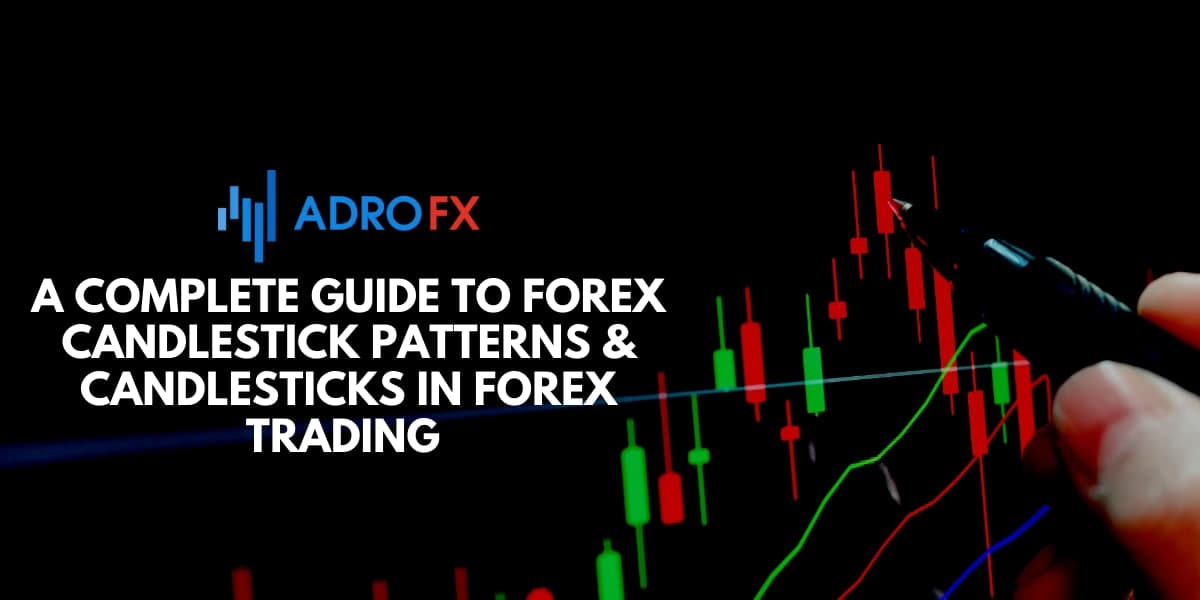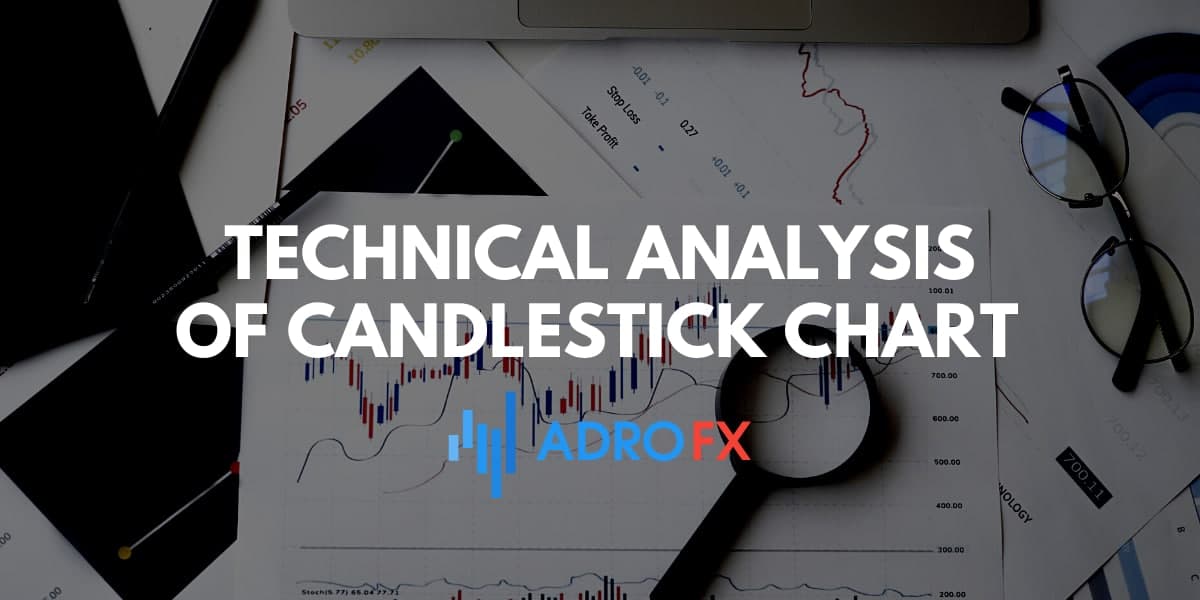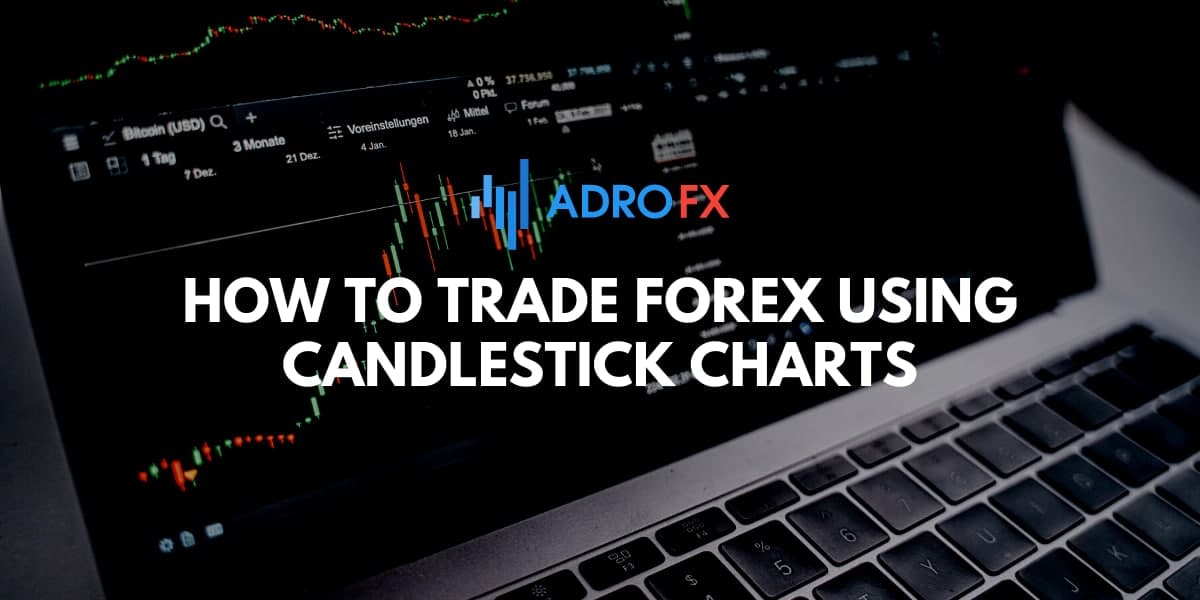A Complete Guide to Forex Candlestick Patterns & Candlesticks in Forex Trading

Every trading book tells us that the price chart is the first source of information that a trader needs to look at, and only then apply any indicators and trading systems.
Indeed, many books are devoted to chart analysis, and candlestick analysis occupies a special hierarchy because trading without using any trading tools is the highest level, which almost all beginning traders strive for.
Over time, traders have identified about three dozen different candlestick patterns, many of which are effective, and others are no longer effective as the markets change.
So, in this article, we will learn what Japanese candlesticks are, how to read forex candlesticks charts, and will get acquainted with the basic candlestick patterns each trader should know.
What Are Candlesticks In Forex?
A Japanese candlestick chart is a type of price line, as well as a type of interval chart, which is used for the graphical display of fluctuations in quotes of all kinds of assets.
The graph in the form of the Japanese candlestick (Japanese Candlestick) is also considered a union of the linear and interval graphs in the sense that either of the elements shows the range of price fluctuations over a certain time frame. Japanese candlestick analysis is used in technical analysis.
A Japanese candlestick chart, in simple terms, is a convenient way to display the price movements of market instruments on the chart in the form of elongated rectangles with tails, resembling forex candlesticks. Each candlestick corresponds to a certain time interval, in which the price movement occurred. The analysis of combinations of candlesticks allows you to make market forecasts even without the use of mathematical technical indicators.
The main difference between a candlestick chart and a standard line chart is that one element contains four indicators instead of one.
The plainness of candlesticks makes it possible to see repetitive graphical patterns that can be used to open positions without studying the chart for a long time. Thus, the information value of graphs increases by an order of magnitude, which greatly simplifies the complex analysis of the market.
In addition, the structure of the candle helps to understand such an important aspect of trading, as the psychology of the market. Graphical analysis using Japanese candlesticks reveals the behavioral patterns of market participants, which in turn allows you to reliably predict the future reaction of the market for certain events.
In technical analysis, candlesticks and their combinations (patterns) help to find important support and resistance levels. It can be used with any time frame available in the trading terminal: depending on the selected period, each candle will be equal to 1, 5, 15, 30 minutes, 1 hour, and so on, up to a month or a year.
What are Japanese candlestick indicators?
Like all other types of market analysis, candlestick charts have their own unique features, knowledge of which is necessary for all traders to save time and effort, and ultimately money.
Candlestick analysis shows itself at its best on a daily chart (D1). The degree of signal reliability falls in proportion to the decrease in the time frame. The time frame below one hour (H1) is considered unreliable.
Analysis of higher time frames - monthly (MN) and weekly (W1) intervals - is used to determine the general long-term trends.
The reversal patterns do not always signal a specific market reversal. Very often after the formation of such a pattern, the correction of the established trend takes place or a flat movement takes place. Therefore, the reversal combination is more likely to signal a change in the situation, rather than a trend reversal.
Models with gaps are considered more reliable than without them. In some patterns the price gap is necessary, but in the forex market, this feature is often neglected because gaps on the currency market occur infrequently.
Forex candlesticks summarize a period’s trading action by visualizing four price points:
- Open
- Close
- High
- Low
The empty and shaded rectangles in the middle of each candle are called the body, and the vertical edges at the top and bottom are called the shadows. The high price (in the period to which the candle corresponds) is at the upper edge of the upper shadow. The low - at the lower edge of the lower shadow, respectively.
The two candlesticks in the picture are different for a reason: a blank candlestick means growth, and a filled candlestick means price decrease. If the open price is lower than the close price, then the price rose during this period. In this case, the candlestick is not shaded; the lower edge of the body indicates the open price, and the upper edge - the close price. If the open price was lower than the close price, the instrument price is falling. In this case, the colored candlestick is displayed; the upper edge of the body shows the open price, and the lower one - the close price.
Most traders prefer the Japanese candlesticks to all other types of charts. The reasons for this preference are obvious: the Japanese candlesticks allow you to easily and quickly see the picture for each period. Not only can you see all four prices for each period, but the Japanese candlesticks also allow you to clearly distinguish the different trading results. The colored candlesticks are immediately visible, and very easy to distinguish from blank candlesticks. The colored candlesticks show the victory of the sellers, and the empty candlesticks show the victory of the buyers.
How to read candlesticks?

The appearance and structure of the forex candlesticks display the behavior of buyers and sellers and allow us to understand the future intentions of the traders. You can learn how to read the chart even without prior study of traditional candlestick patterns.
Body
The first parameter to consider is the size of the candlestick. The longer the body of one candlestick relative to the others, the greater the pressure on the market of buyers or sellers. The large white body indicates that the market is bullish, which means that the buyers were more active at the end of the period. If the candle is dark, the sellers dominate at the close.
If the candlestick bodies are short, it means that it's forming a pullback from the current trend or a flat is coming. It happens when the bulls and the bears are almost equal in strength and the market is in indecision about the future direction of the quotes.
Therefore, it is the candlestick's relative position that is decisive.
A long bullish candlestick, which appears after a long downtrend, may indicate that the sellers' forces are running out, and the trend can be reversed upwards. And when such a candlestick closes above the resistance level, it may indicate that the market fixes at a new price level.
However, we can't be completely sure about what happened when the candlestick was in the formation stage. The way from the opening level to the closing one can be quite straightforward, but there might have been some oscillations in the process. To find out how the period was traversed, you need to switch to 1-2 time frames lower in the terminal, when possible.
Shadow
The long shadow on one side of the candle usually shows the change in market sentiment during the formation of the candle. In traders' jargon, such candlesticks are called "pin bars". They are formed at the extremes and are often a sign of a short-term trend change or the continuation of a long-term trend after the correction. Pin bars are often formed at a strong level, which was tested but not broken. In this case, a large shadow is directed towards the level.
During the periods of maximum opposition between the bulls and bears, a Doji candle is drawn on the chart with a very long shadow. These candlesticks show that the market is in indecision: trades are very active, but it doesn't give any significant result.
To begin with, memorize a few forex candlestick patterns and find them on the chart. Try to use them when analyzing the current market situation - that way you will finally learn these patterns. Then memorize new forex candlesticks and keep practicing.
Main types of candlestick patterns and candles in Forex
There are different types of candlestick patterns and candles in Forex, which help traders to analyze the market situation and make predictions about the further movement of the price chart.
Doji - as a trend reversal signal
A Doji is a candlestick in which the open price is the same as the close price - it has no or almost no body (a very small body).
In general, Doji shows signs of indecision in the behavior of financial market participants, and therefore, as a rule, signals of an approaching reversal of the market (trend). It should also be borne in mind that Doji is of particular importance only in those markets (charts) where they occur not too often. If a Doji occurs too often on any chart, it loses its significance. Likewise, if there is a series of forex candlesticks with small bodies on the chart, the appearance of a Doji in their background will not be important. However, if a trend change is expected in the market (or there has been an uptrend/downtrend for a long time), the appearance of Doji can be a very important signal. This is especially true for a Doji, which appeared after a long white candle in an uptrend. The Doji becomes especially important because it clearly shows that the bulls (those who work for the rising trend) are hesitant to go higher.
Sometimes, when a Doji appears on an important peak or an important base, it can serve as support or resistance, depending on the direction of the trend.
Spinning tops
Candlesticks with a small body size are called " spinning tops". They usually appear during periods of market consolidation.
The spinning tops tell us about the neutral character of the market and appear within a narrow trading corridor. The main difference between a "spinning top" is the small size of the body. The size of shadows usually does not matter much. Very often, the "waves" play an important role in the construction of various graphical models.
Marubozu - candlesticks without shadows
Marubozu is a type of Japanese candlestick, which has no (or very small) upper and lower shadows. Moreover, the smaller the shadow, the stronger the signal.
A white candlestick indicates that the open price coincides with the low and the close price - with the high for the analyzed period. It reflects a "bullish mood" in the market.
If the candle is black, it indicates that the open price coincides with the high and the close price coincides with the low of the trading time frame. Its appearance indicates a greater prevalence of "bearish" sentiment in the market.
Using different types of Japanese candlesticks in our work, we get much more information from the charts to understand and analyze the market than if we use line or bar charts. The various combinations created by the candlesticks give us useful information about the market conditions and the direction of the trend. Also, it should be noted that the theory about candlesticks is because the size and the relative position of the candle body and the shadows, as well as the relative position and color of neighboring candles, can signal the continuation of the movement, the slowdown or reversal of the trend. Therefore, it is necessary to learn to read and understand the signals given by the various patterns of forex candlesticks.
Basic Candlestick Chart Patterns
There are countless candlestick patterns that traders can use to identify areas of interest on a chart. They are used for day trades, trading on price swings, and even when opening long-term positions. While some patterns can indicate a balance between buyers and sellers, others show a reversal, continuation (consolidation), or indecision by market participants.
It is important to note that candlestick patterns themselves are not necessarily a signal to buy or sell. Instead, they represent a way to take a deeper look at market structure and potential signs of upcoming opportunities, which is the reason why it is desirable to familiarize yourself with such patterns in their proper context. It can be the context of the technical pattern on the chart, as well as the broader market environment and many other factors.
In a nutshell, like any other market analysis tool, candlestick patterns are most useful when used in conjunction with other methods. This can be the Wyckoff Method, Elliott Wave Theory, and Dow Theory, which can also include technical analysis indicators such as trend lines, Moving Averages, Relative Strength Index (RSI), Stochastic RSI, Bollinger Bands, Ichimoku Clouds, Parabolic SAR, or MACD.
The Hammer and the Hanging Man
These are important reversal signals at the top and the base of the trend. The distinctive feature of these patterns is that they have the same signs, and the color of the body does not matter. In essence, it is the same formation consisting of a single candle, and its name will depend on which trend it was formed.
Hammer - it appears in a downtrend and signals the end of a bearish trend. In Japanese such a candle is also called Takuri, which roughly means "to measure the bottom, groping for it with your foot.
Hanging Man appears during an ascending trend and signals the end of a bullish trend.
These patterns can be recognized by three points:
- The body of the candlestick is small and at the top of the range, and its color does not matter;
- The lower shadow should be at least twice if the body
- The upper shadow is absent or has a very small size.
Since these patterns are reversal patterns, it is important to look for them only on pronounced trends. Signals on a sideways trend will be false in most cases.
Some of the amplifying factors include the following:
- The smaller the body, the longer the lower shadow, and the shorter the upper shadow, the stronger the signal;
- When identifying a pattern, its color does not matter, but it is worth considering it when determining its strength. The Hammer with the white body and the Hanging Man with the black one will have more pronounced signals;
- The signal intensifies when the pattern is formed at important support and resistance levels.
Like all candlestick patterns, Hammer and Hanging Man work well on time frames from H1 and higher. Their signals are considered reliable, but you should not use them without additional supporting signals. Applying various indicators as filters, you can weed out most of the false signals. You should open a position only after the closing of a pattern candle, and place a Stop-Loss at least 20 points from the pattern candle.
Inverted Hammer
Inverted hammer - a candlestick with a small square body, any color, a large upper shadow (2 or more body lengths), absent or small lower shadow (no more than 10% of the body).
This figure, as well as its initial variant, is located only at the end of the downtrend. It is a reversal figure and predicts the beginning of ascending movement.
If a similar pattern is formed in an uptrend, it is a Shooting Star - a completely different pattern of candlestick analysis.
The candlestick pattern Inverted Hammer has the following characteristics:
- The body of the candle is small in the shape of a square;
- The upper part of the pattern is elongated and several times longer than the body;
- There is no lower shadow, or it is very short;
- It appears only during a descending trend;
- The spread on the daily price highs/lows is higher than that of neighboring candlesticks.
The three white soldiers
As the name indicates, the pattern consists of 3 candlesticks. At that, all the bars are green (white, i.e. bullish) and go in a row, rising sequentially. The combination of these bars demonstrates that the bulls are pushing the price up.
If the pattern appears against the background of a strong downtrend, the signal becomes stronger. At the same time, the shadows of the bars should not be present or they should be very insignificant, as in the figure.
Tweezer (Tops/Bottoms)
This candlestick pattern is a typical reversal formation, which can be found on various charts of trading instruments. Developed relatively recently, it has managed to enter the list of the most common in the traders' environment. In addition, Tweezer occurs much more often than other candlestick patterns, because the conditions of formation are simpler. What also distinguishes the Tweezer pattern from many other shapes is the fact that it is not necessary to consider only high time frames, it can be traded even on an hourly time frame.
The pattern is based on a simple and at the same time effective pattern - if the price fails to overcome the same level twice, it increases the probability of the trend changing direction. In practice, this is implemented in a fairly well-known pattern of graphical analysis - Double Top and Double Bottom. But there is a significant difference in Tweezer's, it is that these extremums are located at the same level. There is a small assumption, but it is quite insignificant and amounts to literally a few points even for large periods. The fact that it is a specific level rather than a conventional area indicates that there is a high demand or supply in those ranges and that often leads to really quick reversals. Further attempts to break through the level are also possible and in the case of Tweezer's, they will not succeed, and the price will also be pushed back.
Shooting Star
The Shooting Star, like many other patterns, has its counterpart. The pattern is like the Inverted hammer. However, the incorrect identification of these figures threatens the trader with serious losses, because in this case, the Hammer predicts the growth, while the Star - the fall in prices.
Candlestick pattern Shooting Star is a single short candle pattern that appears on an uptrend and signals the change of trend to a downtrend.
It is a reversal-type pattern that appears near resistance levels, heralding the end of the rise in prices.
On the chart, the pattern is a candle with a small body, a long upper shadow, and a small (or missing) lower shadow. It may be either light or dark in color, but the dark color suggests a stronger sell signal.
This candle structure can be interpreted as follows. In a rising market, the strength of the bulls prevailed, but at some point, the price increase reaches a resistance level. The buyers are attempting to break through this level, and if they succeed, they do not form a pattern.
If the buyers' attempt to do so fails, the long shadow of a candle remains of their former strength - an attempt to break through. The appearance of a short candlestick body indicates a gradual shift of power from the bulls to the bears.
Three Black Crows
The pattern consists of 3 consecutive bearish candlesticks, with each successive one opening within the body of the previous one and closing below its minimum. The result is a "ladder" of 3 "steps".
Dark Cloud Cover
This pattern is represented by a bullish candlestick that opens above the closing price of the previous bearish bar and then closes below the middle line of the same bar. Often, such a pattern is accompanied by the appearance of large volumes, which can be determined with the help of MFI data and other technical algorithms.
Rising Three Methods
This is a simple pattern represented by 3 bullish candles with small bodies. They should go down consistently, without gaps, as shown in the chart. To be sure of the continuation of the trend, you must also wait for the fourth bullish bar with a large body to appear, which should come immediately after the first three. After that, we can expect the current trend to continue.
Falling Three Methods
This combination indicates a continuation of the downtrend. The essence is exactly the same, only the pattern looks like a mirror image of the previous pattern.
Technical analysis of candlestick chart

One of the most important purposes of technical analysis is to detect changes in price direction. Since forex candlesticks provide a visual representation of market psychology, one of the most useful aspects of candlestick analysis is its ability to suggest changes in market sentiment and changes in trend. It is important to note that with candlestick patterns, the reversal pattern does not necessarily suggest a complete change in trend, but simply a change or pause in direction.
The Japanese traders who invented this system gave their patterns colorful names. Each of these patterns includes sound trading principles that emphasize the classic interpretation of each particular candlestick pattern. The ability to recognize and understand the interpretation of multiple candlestick patterns is a powerful trading tool for any financial market. In addition, for forex traders, knowing and understanding candlestick patterns adds additional depth to their knowledge of technical analysis and their ability to use it effectively when trading currencies.
Forex candlestick patterns are crucial for the technical analysis of the price action of currency pairs. Candlestick pattern indicators are formed on Japanese candlestick charts that visualize the price action of currency pairs.
Useful tips
There is nothing super complicated in the following tips we have prepared for you, these are the usual market principles as applied to the graphical analysis of candlestick patterns:
- All the parameters of a forex candlestick (price, range (size), direction (color), the configuration) are evaluated only after it closes;
- The higher the time frame analyzed, the more reliable the candlestick pattern;
- Any reversal pattern must be preceded by a trend segment - upward or downward;
- Reversal candlestick patterns show a high probability of a trend change, but do not allow us to estimate the potential for further movement;
- The longer the body of the candlestick, the greater the potential for movement in this direction;
- The smaller the shadow of a closed candlestick, the greater the probability of movement in this direction;
- Standard reversal patterns can perform a continuation pattern if applied on a pullback from the main trend;
- There are no perfect candlestick patterns, as there is always market noise on the market;
- Market entry based on a candlestick signal is carried out only if it agrees with the trend direction and is confirmed by other indicators.
Advantages and disadvantages of forex candlestick analysis
Like any type of market analysis, forex candlestick analysis has some advantages, but it is also not without some disadvantages.
Among the advantages we can mention the following ones:
- Reliability. The Japanese candlesticks, in contrast to any technical indicators, allow you to analyze the behavior of prices, rather than the results of mathematical calculations. It is important because we know that the best market indicator is the price itself.
- Universality. Candlestick analysis of financial charts is suitable for any market - currency, futures, commodity, stock, and others.
- Dissemination. The candlestick chart mode is present in any trading terminal, and it is not necessary to install any special software.
The only disadvantage is the complexity of learning. The candlestick analysis is not a simple type of market analysis, and it will take a trader many hours to learn and use it in practice. However, with proper persistence, candlestick patterns will stick in the memory, and the work will be virtually automatic.
How To Trade Forex Using Candlestick Charts

For most traders, candlestick bodies are more important than their shadows. That is, the opening and closing prices of the period are in the first place, and the lows and high are secondary. The shadows refer to the market noise, but this noise also deserves close attention.
The candlestick analysis uses some basic principles:
- Short shadows with long bodies are trend-building candlesticks. Such elements show a strong bullish or bearish dominance, depending on the coloring;
- The longest bodies will be located at the beginning and the end of the trend wave. The next point to remember: when forex candlesticks with long bodies are formed after a long upward impulse, it is necessary to close the trade;
- Small bodies with long tails are formed on trend reversals. First of all, it concerns the cases when one of the shadows has a considerable predominance over the other tail and body. Conditionally, it can be considered that this is the appearance of large candlestick bodies. The appearance of such elements means that during the period, the traders trading in one direction prevailed, but as a result, the course of trading was reversed by the participants who chose the opposite direction;
- Small bodies and shadows are formed during sideways trends. They provide an opportunity to open positions with short Stop-Losses.
Moreover, learning how to how to read forex candlesticks you should know that the significance of each reversal pattern can be increased or decreased under certain conditions, like these:
- The longer the time the trend continues, the stronger the pattern signal;
- The steeper the formed trend, the more reliable the signal;
- Reversal patterns deserve attention only when they are formed near strong support/resistance levels;
- The strength of the signal increases in cases where Tweezers were formed in the course of the nearest sessions.
For patterns that are formed by 1-2 candles, the following features are relevant:
- The combination loses significance if it has already appeared in the course of the current movement;
- You should not take a candlestick pattern by itself as a signal to open a trade. Patterns show only the mood of the market and its likely changes;
- In the Japanese literature on candlestick analysis, you can find claims that some of the reversal bearish patterns are stronger than their bullish counterparts. However, the practice of using candlesticks in forex has shown that this is not true for this market.
No other method of price chart analysis can compete with the Japanese candlesticks in terms of clarity and simplicity. The analytical tool developed by Japanese traders is the best way to identify the prevailing mood of the market participants and its changes. That is, it helps to easily understand the essence of trading.
About AdroFx
Being a well-established brokerage company, AdroFx offers the best trading conditions to its clients from 200 countries. Founded by experts with a couple of decades of the overall experience, AdroFx is one of the best platforms on the market for shares trading. Either a newbie or experienced trader, both will find here what they are looking for since the company provides various trading accounts for different trading styles and goals.









